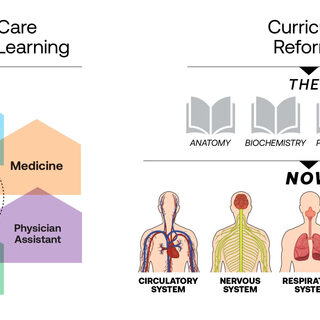Tradeline's industry reports are a must-read resource for those involved in facilities planning and management. Reports include management case studies, current and in-depth project profiles, and editorials on the latest facilities management issues.
Latest Reports
Medical and Health Education Buildings Serve as a Model for a Hybrid Future
The design and planning of medical and health sciences education facilities serve as both the precursor and the wave of the future, with facilities that are not only mixed-use, but truly hybridized and integrated. Formerly siloed programs for nursing, medical, surgical, and pharmaceutical training reap exponential benefits from shared technology, resources, and spaces that enable multiple institutions and stakeholders to offer more robust programs. The hybrid building model mirrors a coevolving approach to healthcare, where teamwork is central, and training with the latest technologies is key. By accommodating the functions of multiple disciplines, forward-thinking institutions can both leverage available space and focus on creating environments for the interpersonal collaboration that underpins the experience of 21st-century health practitioners, as well as that of their patients.
Mandate vs. Magnet: Designing the Office You Need Now
Three years after the end of the pandemic, office occupancies have still not gone back to where they were pre-COVID, and there is a wide range of opinions about whether they should. While some executives have ordered everyone back into the office, arguing that being physically present facilitates engagement and innovation, many workers argue that their working life and their home life are better when they can choose where they log on.
Missouri Science & Technology Unveils a Showcase for Advanced Manufacturing
Advanced manufacturing (AM) experts say companies around the country that are currently trying to build up their AM capabilities are held back by three things: experience with cutting-edge AM equipment, experts who can show how to take full advantage of such equipment’s capabilities, and highly trained workers who have the skills to operate the equipment. Administrators at the Missouri University of Science and Technology in Rolla hope to fill all three gaps with the help of a new facility they call The Missouri Protoplex.
New Space Strategies for Healthcare
Hospitals and healthcare systems are stepping up to manage difficult choices. COVID funds have expired, staff are difficult to find and expensive to hire, and reimbursements aren’t keeping up with inflation. For those who are planning new and renovated healthcare spaces, the focus is on becoming more labor- and cost-efficient, benefiting from technology-driven ways of delivering healthcare while not losing the personal, human touch.
The Key to Donor Engagement
With funding for research under pressure at the same time that colleges and universities are looking to grow their student body, institutions are relying more on philanthropy than ever before. How do you capture the “value intersection” between the donor’s story, the institution’s unique character, and the aspirations of the prospective student? In this webinar, Advent CEO John Roberson, and Grace Johnson, client engagement manager at Advent, use case studies from Belmont University, the University of Wyoming, and the University of Southern California to demonstrate how to translate those stories into a physical space that can then attract even more philanthropy.





